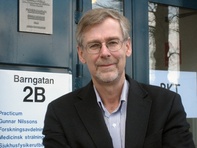Seminars on fMRI
Seminar 1: Basics of MRI and possible applications
Mikael Roll and Merle Horne
Feb 9, 2012, at 10:15 in H428b
References
Amaro, E and Barker, G.J. 2006. Study design in fMRI: Basic principles. Brain and Cognition 60, 220–232.Ramsey, N.F., Hoogduin, H., and Jansma, J.M. 2002. Functional MRI experiments: acquisition, analysis and interpretation of data. European Neuropsychopharmacology 12, 517–526.
Seminar 2: Prof. Freddy Ståhlberg

March 1, 2012, at 10:15 in H428b
Freddy Ståhlberg, professor of MR physics at the Department of Medical Radiation Physics will give further introduction to MRI. He will also present the MRI facilities at Lund University and some of the ongoing research.
Seminar 3
March 22, 2012, at 10:15 in H428b
In the third seminar on fMRI, we discussed how experiments can be designed, different experimental paradigms, and what factors need to be considered. Participants were welcome to bring their own ideas for discussion, as did Carita Paradis, Professor of English Linguistics, and Conny Blom, guest researcher at the Department of Art History.
Seminar 4
April 12, 2012, at 10:15 in H428b.
We continued talking about research ideas, and how they can be designed as fMRI experiments, pointing out methodological issues that need to be borne in mind when designing the experiments. Experiment ideas taken up by Mechtild Tronnier and Eva Klingvall were discussed.
Strategic development of attention in cue-target paradigms. A Bayesian interpretation.
Carlos Gómez, University of Seville
Thursday, May 24, 10:15-12:00 in H428b
Endogenous attention is conceived as the process of modulating neural resources as a function of the credibility of an attended cue. It is possible that the intensity of attention to cues would be constantly updated as a function of the outcome of previous trials. The present approach is based on human electrophysiological studies of Posner's central cue paradigm, which provides the possibility to dissociate the following processing steps: (i) preparation for certain stimuli, (ii) evaluation of the validity or invalidity of the preparatory state, and (iii) the feedback cycling of the information extracted from one trial to the next.
Behavior and event-related brain potentials were recorded during experiments in which a cue predicts with a probability of 0.8 the position where the target stimulus will be presented. Results showed that the response times to targets, preparation for next target, and P300 amplitude were modulated by the outcome of previous trials.
The processes of preparation, evaluation and changing a cue's predictive value on a trial-by-trial basis conform a cycle that permits behavior to be constantly updated. The presented results can also be considered in relation to the computational Bayesian brain framework. This trial-by-trial learning would be a potential basis for organism adaptation. During sentence processing, the probability for a given word to be selected increases or decreases as a function of the previously selected words. Therefore the predictive value of previous words must be taken into account when analyzing the impact of a certain word in the sentence.
Maturation of spontaneous EEG from childhood to young adults
Carlos Gómez and Elena Rodríguez, University of Seville
Friday, May 25, 13:15-15:00 in H428b
The adolescent period is a crucial developmental moment of transition from childhood to emergent adulthood. It is also a period in which many different types of mental and behavioral problems can arise. The EEG is able to provide information on two types of brain activity: spontaneous brain activity and event-related potentials. This presentation focuses on the spontaneous brain activity during the peri-adolescent period.
The EEG is not stable over development, but it is changing until arriving to the typical adult pattern. Several topics have been in the focus regarding the EEG development of control children: EEG power developmental trajectories, the establishment of developmental equations, brain complexity, topographical changes during development, coherence developmental trajectories and the relationship between the maturation of the EEG and neuroanatomical and cognitive maturation.
The differences in the spontaneous EEG of late childhood and young adults will be presented with a narrow frequency band analysis strategy. Main results indicate a developmental asynchrony of different brain rhythms, a frequency increase and amplitude decrease with development, early maturation of posterior EEG with respect to anterior sites, and a complete latent structure of the of the EEG in late childhood.
Some preliminary results on the relationship of spontaneous EEG development and working memory development, including the phonological loop, will also be presented.
The present results provide a rationale for trying to inter-relate the maturation of spontaneous EEG in children with the acquisition and improvements of cognitive functions with age.
